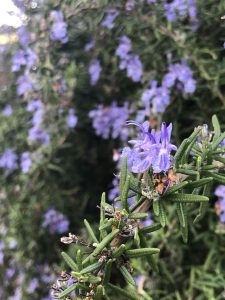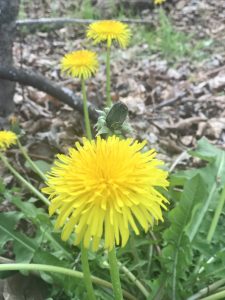 Spring. What better way to awaken then immersing myself in green: plants, flowers, trees, fungi. My friends Marty, Janie and I joined Karen Sherwood of Earthwalk Northwest for a Wild Food Foraging Spring Celebration. A day: in the weeds, the kitchen, the dining room. We met in the Earthwalk classroom where Karen introduced ethical principles and of wild food foraging guidelines. She explained how plants and medicine go hand in hand. Bringing wild foods onto our plates is a way to reconnect with the earth. Our food sources are becoming compromised and depleted. They lack the micronutrients we need to truly flourish. In Bread, Wine Chocolate, author Simran Sethi, describes the last century’s dramatic shifts we’ve experienced in food and agriculture. Foods are beginning to look and taste the same. Ninety-five presence of the world’s calories are now coming from only 30 species. Our foods are primarily made up of corn, wheat, rice, palm oil and soybeans. We are losing the delicious, diverse variety of food. Karen encouraged us to learn to incorporate wild foods in our diet every day. In learning about one new plant friend a week we develop a relationship with the life forms that sustain us. Continue reading
Spring. What better way to awaken then immersing myself in green: plants, flowers, trees, fungi. My friends Marty, Janie and I joined Karen Sherwood of Earthwalk Northwest for a Wild Food Foraging Spring Celebration. A day: in the weeds, the kitchen, the dining room. We met in the Earthwalk classroom where Karen introduced ethical principles and of wild food foraging guidelines. She explained how plants and medicine go hand in hand. Bringing wild foods onto our plates is a way to reconnect with the earth. Our food sources are becoming compromised and depleted. They lack the micronutrients we need to truly flourish. In Bread, Wine Chocolate, author Simran Sethi, describes the last century’s dramatic shifts we’ve experienced in food and agriculture. Foods are beginning to look and taste the same. Ninety-five presence of the world’s calories are now coming from only 30 species. Our foods are primarily made up of corn, wheat, rice, palm oil and soybeans. We are losing the delicious, diverse variety of food. Karen encouraged us to learn to incorporate wild foods in our diet every day. In learning about one new plant friend a week we develop a relationship with the life forms that sustain us. Continue reading
Monthly Archives: April 2019
Seattle Urban Foraging Scavenger Hunt!
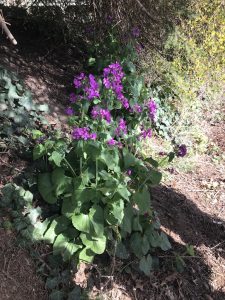 Last Saturday JT, Ethnobotany Guide Extraordinaire, lead us, ethnobots, on a foraging walkabout around the Seattle Jackson Place, Judkins Park and International District. She made it fun by challenging us to a scavenger hunt. She interwove plant observations along with the multi-cultural stories of the people who made their homes here. This was a powerful learning about place: Seattle is home to many cultures; it has a history of discrimination and displacement. Sort of like the plants that end up here – they are blown in from the wind or carried by birds. Some of those winds are the harsh forces of conflict in home countries. Immigrants and refugees take root and are then uprooted again by powerful economic and social forces.
Last Saturday JT, Ethnobotany Guide Extraordinaire, lead us, ethnobots, on a foraging walkabout around the Seattle Jackson Place, Judkins Park and International District. She made it fun by challenging us to a scavenger hunt. She interwove plant observations along with the multi-cultural stories of the people who made their homes here. This was a powerful learning about place: Seattle is home to many cultures; it has a history of discrimination and displacement. Sort of like the plants that end up here – they are blown in from the wind or carried by birds. Some of those winds are the harsh forces of conflict in home countries. Immigrants and refugees take root and are then uprooted again by powerful economic and social forces.
Plants and people grow toward light. We all want to flourish and enjoy the fruits of our labors. These fruits can be seen in the Central District neighborhood homes, churches and temples, community centers, gardens and parks. Native and ornamental plantings were everywhere – adorning yards and also breaking through the cracks in the sidewalks. We began our walkabout in JT’s neighborhood, once predominantly Italian American. We hunted herbs for the heart, liver and mind.
Hawthorn is a tree in the rose family that grows all over the Northern Hemisphere. Its high favonoid content has been shown to decrease inflammation and oxidative stress. Hawthorn has helped to reduce heart problems including high blood pressure and improve heart function. 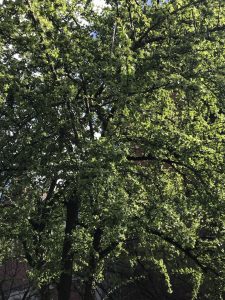 Fall berries can be made into honeys and jams. “Hearty” Hawthorn seems at home in the city. I discovered it just a few years ago when coming upon some Russian emigres picking red berries on the Snoqualmie River. They explained that the berries were “very strong heart medicine.”
Fall berries can be made into honeys and jams. “Hearty” Hawthorn seems at home in the city. I discovered it just a few years ago when coming upon some Russian emigres picking red berries on the Snoqualmie River. They explained that the berries were “very strong heart medicine.”
Dandelions have long been used by herbalists to support liver health. Roots can be boiled to make a decoction or dried and roasted to make a fine tea. Flowers and leaves are edible. 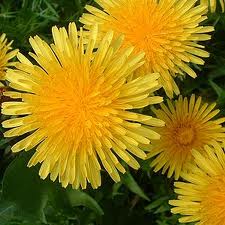 I’ve experimented with greens in salads, pestos and soups. Last week we enjoyed dandelion blossom shortbread cookies. Gather the blossoms in the sun and it will bring happiness.
I’ve experimented with greens in salads, pestos and soups. Last week we enjoyed dandelion blossom shortbread cookies. Gather the blossoms in the sun and it will bring happiness.
Rosemary is a member of the mint family which includes many other herbs, such as oregano, thyme, basil, and lavender. Rosemary is rich in anti-oxidants and anti-inflammatory compounds, which are thought to help boost the immune system and improve blood circulation. 
Scientists have found that rosemary may also be good for your brain. Rosemary contains an ingredient called carnosic acid, which can fight off damage by free radicals in the brain. Some studies have suggested that rosemary may significantly help prevent brain aging. Research continues on rosemary’s possible uses in treating Alzheimers.
Dandelion Heaven
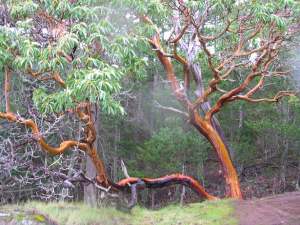 This Wednesday, we had our tenth Ethnobotany Apprenticeship class with Earthwalk Northwest. JT introduced today’s mystery plant: Pacific Madrona. She made a tea infusion with bark, leaves and flowers. JT brought leaves, bark and blossoms and a beautiful wooden bowl. The tea was mild and astringent, the blossoms sweet. Medicinally, the bark tea can be used for colds and stomach issues. Its hard wood was used by native people for gambling sticks, bowls and necklaces. Pacific Madrona, Arbutus menziesii, is part of the Heath, Ericaceae, family. The tree grows from Vancouver Island, south through the Cascade lowlands all the way down to San Diego County. Madrone berries are prized as by birds, rodents, deer, and wood rats.
This Wednesday, we had our tenth Ethnobotany Apprenticeship class with Earthwalk Northwest. JT introduced today’s mystery plant: Pacific Madrona. She made a tea infusion with bark, leaves and flowers. JT brought leaves, bark and blossoms and a beautiful wooden bowl. The tea was mild and astringent, the blossoms sweet. Medicinally, the bark tea can be used for colds and stomach issues. Its hard wood was used by native people for gambling sticks, bowls and necklaces. Pacific Madrona, Arbutus menziesii, is part of the Heath, Ericaceae, family. The tree grows from Vancouver Island, south through the Cascade lowlands all the way down to San Diego County. Madrone berries are prized as by birds, rodents, deer, and wood rats. 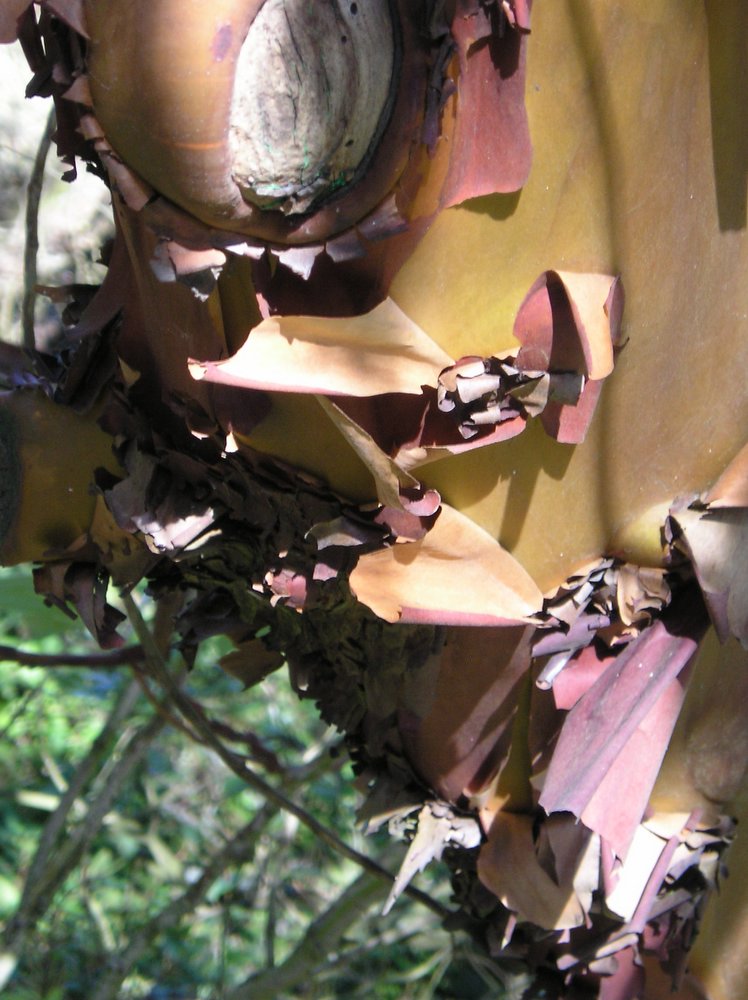 At least five species of birds, especially the mourning dove and band-tailed pigeon, devour berries and then disseminate the seeds. According to the U.S. Forest Service, “. . . the longevity of madrone is not known, the species has been referred to as “giving evidence of being long lived.” Trees 200 to 250 years old have been recorded and large specimens are estimated to be 400 to 500 years old.” I remember seeing its beautiful rusty skin peeling down its smooth slender trunk along the Marin County coastal bluffs and in the lowland areas around Yosemite National Park. Continue reading
At least five species of birds, especially the mourning dove and band-tailed pigeon, devour berries and then disseminate the seeds. According to the U.S. Forest Service, “. . . the longevity of madrone is not known, the species has been referred to as “giving evidence of being long lived.” Trees 200 to 250 years old have been recorded and large specimens are estimated to be 400 to 500 years old.” I remember seeing its beautiful rusty skin peeling down its smooth slender trunk along the Marin County coastal bluffs and in the lowland areas around Yosemite National Park. Continue reading
For-giving
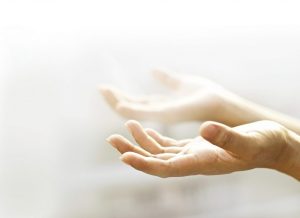 Our Moving into Meditation class explored forgiveness. We drew inspiration from Jack Kornfield’s book, No Time Like the Present: Finding Freedom, Love and Joy Right Where You Are. In Chapter 6, Forgiveness, Jack explores the various ways past experiences weigh us down and color our perception. He suggests that we intentionally cultivate an all- encompassing awareness to include ourselves and others in our circle of loving kindness. Forgiveness is a lifelong healing practice. Poet Jane Hirshfield describes the letting go that living demands of our hearts. Living is for-giving. Continue reading
Our Moving into Meditation class explored forgiveness. We drew inspiration from Jack Kornfield’s book, No Time Like the Present: Finding Freedom, Love and Joy Right Where You Are. In Chapter 6, Forgiveness, Jack explores the various ways past experiences weigh us down and color our perception. He suggests that we intentionally cultivate an all- encompassing awareness to include ourselves and others in our circle of loving kindness. Forgiveness is a lifelong healing practice. Poet Jane Hirshfield describes the letting go that living demands of our hearts. Living is for-giving. Continue reading

